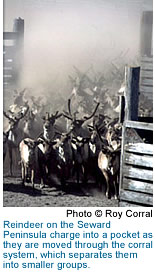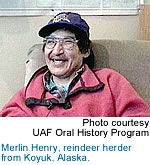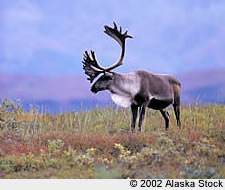Return of the Caribou
October 2004
By Marie Gilbert, Institute of Arctic Biology
The caribou would return, the elders said.
 More than a century after they were last seen in their winter range on Alaska's Seward
Peninsula, tens of thousands of caribou are migrating back into the area, just as
the ancestors of present-day reindeer herders predicted. The wild caribou represent
fresh meat for the villagers, but when they move on, the domesticated reindeer go
with them.
More than a century after they were last seen in their winter range on Alaska's Seward
Peninsula, tens of thousands of caribou are migrating back into the area, just as
the ancestors of present-day reindeer herders predicted. The wild caribou represent
fresh meat for the villagers, but when they move on, the domesticated reindeer go
with them.
"The caribou are just overwhelming. I don't think I have a single reindeer on my range, but I renewed my grazing permit for my area thinking about what healthy meat can do to my people; a healthy source of protein that we've grown to love and to live by is gone. I hope it's not gone forever," said Shaktoolik herder Palmer Sagoonick.
![[QUOTE: The caribou are just overwhelming.]](/news/archives/news-archives-2002-2010/featured/04/reindeer/images/callout1.gif) University of Alaska Fairbanks researchers are studying how climate change and returning
caribou are affecting reindeer herding in northwest Alaska. The researchers asked
peninsula herders to describe how their families and communities are coping with the
loss of animals, and in some cases, the loss of entire herds of reindeer to outmigration
with caribou.
University of Alaska Fairbanks researchers are studying how climate change and returning
caribou are affecting reindeer herding in northwest Alaska. The researchers asked
peninsula herders to describe how their families and communities are coping with the
loss of animals, and in some cases, the loss of entire herds of reindeer to outmigration
with caribou.
Oral histories collected from Sagoonick and other herders are part of the "Reindeer Herding in Transition" research project led by Knut Kielland, Greg Finstad, William Schneider and Josh Greenberg of UAF, and Rose Atuk Fosdick of the Kawerak Reindeer Herders Association.
"The project is an interdisciplinary study of the ecological and socioeconomic ramifications of the unprecedented and massive influx of caribou from the western arctic caribou herd onto ranges on the Seward Peninsula during the last decade," said Kielland, Institute of Arctic Biology researcher and the project's principal investigator.
"This ecological event stands to have drastic effects on reindeer herding in western Alaska and may serve as an insightful model of the feedbacks between climate change, environmental vagaries and human land use in the circumpolar Arctic," Kielland said.
 "We recognize that caribou are an important subsistence food for local people," Fosdick
pointed out. "They are a welcome resource, so despite the problems they cause reindeer
herders, it's not all negative to have caribou influx into the region." The herders
association provides support toward developing a self-sustaining reindeer industry.
"We recognize that caribou are an important subsistence food for local people," Fosdick
pointed out. "They are a welcome resource, so despite the problems they cause reindeer
herders, it's not all negative to have caribou influx into the region." The herders
association provides support toward developing a self-sustaining reindeer industry.
"During the first part of the project we documented the return of the caribou and the decline of the reindeer, now we want to see how people are adapting and adjusting to that change," said Finstad, manager of the Reindeer Research Program at UAF's School of Natural Resources and Agricultural Sciences.
"We want to look more into the nitty gritty of how management is going to be changing and how herders are coping by seeking additional income opportunities," Kielland said. "People now have wage jobs -- as cab drivers, hunting and fishing guides, snow plow contracts with the FAA and DOT. We want to see what are the consequences of wage diversification, of keeping animals on more restrictive ranges, of intensification of management style and of increased reliance on technology such as satellite collars and the Internet," said Kielland.
![[QUOTE: The oral history project is a way to pass traditional knowlege on.]](/news/archives/news-archives-2002-2010/featured/04/reindeer/images/callout2.gif) "Oral history is not so much about the recordings but finding ways to retell stories
so future generations know their history,"said Rasmuson Library's Curator of Oral History Bill Schneider. "You can't pour science into local knowledge
or vice versa without context. We created a context that was a combination of the
knowledge of the herders, Knut and Greg." Schneider recorded interviews with the reindeer
herders conducted by Kielland, Finstad and himself.
"Oral history is not so much about the recordings but finding ways to retell stories
so future generations know their history,"said Rasmuson Library's Curator of Oral History Bill Schneider. "You can't pour science into local knowledge
or vice versa without context. We created a context that was a combination of the
knowledge of the herders, Knut and Greg." Schneider recorded interviews with the reindeer
herders conducted by Kielland, Finstad and himself.
"The oral history project is something we have wanted to do within the Kawerak Reindeer Herders Association for many years," Fosdick said. "It's a way to pass traditional knowledge on.”
The four-year project is funded by the Human Dimensions of the Arctic System program of the National Science Foundation's Arctic Systems Science program.
Reindeer Herders on the Air
 Excerpts from the oral history recordings were made into a radio program, Heritage of Reindeer Herding: Voices of Herders on the Seward Peninsula and Alaska, which was broadcast through UAF's KUAC-FM and is available on the Internet. In The History of Reindeer Herding, the initial program in the series, herders talk about Laplanders who came from Norway
in the late 1800s and early 1900s to Alaska to teach reindeer herding techniques,
how the herding business grew and flourished, and herds thrived, crashed, recovered
and are again facing decline.
Excerpts from the oral history recordings were made into a radio program, Heritage of Reindeer Herding: Voices of Herders on the Seward Peninsula and Alaska, which was broadcast through UAF's KUAC-FM and is available on the Internet. In The History of Reindeer Herding, the initial program in the series, herders talk about Laplanders who came from Norway
in the late 1800s and early 1900s to Alaska to teach reindeer herding techniques,
how the herding business grew and flourished, and herds thrived, crashed, recovered
and are again facing decline.
In the second episode, The Heritage of Herding Families, herder Palmer Sagoonick explains how he draws a sense of identity from carrying on his ancestors' skills. Other herders share stories of children being taken out of school for months at a time to learn the customs and the culture of herding, how apprentices earned animals in payment for learning herding skills from visiting Siberian and Norwegian herders, and why the villagers have hope for the future of reindeer herding.
In The Technology of Reindeer Herding, herders discuss the effects of new technologies such as helicopters, four-wheelers, snowmachines and radio collars which are helpful to herders, but at a cost that isn't always affordable.
 "I have to pay for my snowmachine parts, like a track, skis," said herder Merlin Henry
of Koyuk. "With 800 to 1,000 reindeer, you can operate with what you make off reindeer
all year round. You can't handle reindeer if you [only have] 200, unless you got money
in the bank, but that money in the bank don't last because you got to buy a new snowmachine
to keep up with the reindeer."
"I have to pay for my snowmachine parts, like a track, skis," said herder Merlin Henry
of Koyuk. "With 800 to 1,000 reindeer, you can operate with what you make off reindeer
all year round. You can't handle reindeer if you [only have] 200, unless you got money
in the bank, but that money in the bank don't last because you got to buy a new snowmachine
to keep up with the reindeer."
Herders talk about the challenges they face from wild caribou streaming onto the peninsula in record numbers and "taking" reindeer with them when they migrate in episode four, The Caribou Crisis. Climate change and depleted food sources in the caribou's range may be prompting the influx of caribou to the peninsula, and range depletion from caribou may permanently affect future reindeer herding.
Heritage of Reindeer Herding: Voices of Herders on the Seward Peninsula and Alaska was produced by Kathy Turco, a UAF marine biology graduate and owner of Alaska's Spirit Speaks.

Reindeer herders from Lapland and their families were photographed in San Francisco before the final leg of their long journey to Alaska. More information is available at History of Reindeer in Alaska.

Once in a corral, reindeer are funneled into smaller and smaller pens until a single reindeer can enter a soft squeeze chute and can then be handled.

Reindeer gather in a corral on Alaska's Seward Peninsula.

A reindeer herder on Alaska's Seward Peninsula inspects his snowmachine. New technologies such as snowmachines have provided improvements to herders, but at a cost that isn't always affordable.

A caribou stands on the Fall tundra.
For more information, please contact:
- Marie Gilbert, Publications and Information Coordinator, UAF Institute of Arctic Biology, (907) 474-7412, marie.gilbert@uaf.edu
- Knut Kielland, Professor, UAF Institute of Arctic Biology, (907) 474-7164, ffkk@uaf.edu
- Greg Finstad, Program Manager, Reindeer Research Program, UAF School of Natural Resources and Agricultural Sciences, (907) 474-6055, ffglf@uaf.edu
- William Schneider, Professor and Curator of Oral History, UAF Elmer E. Rasmuson Library, (907) 474-5355, ffwss@uaf.edu
- Josh Greenberg, Department Chair and Professor, Resource Management Department, (907) 474-7189, ffjag@uaf.edu
- Rose Atuk Fosdick, Administrator, Kawerak Reindeer Herders Association, (907) 443-4377.
- Kathy Turco, Owner/Recording Artist, Alaska's Spirit Speaks: Sounds and Science, (907) 455-4286, kath@alaskas-spirit.com


